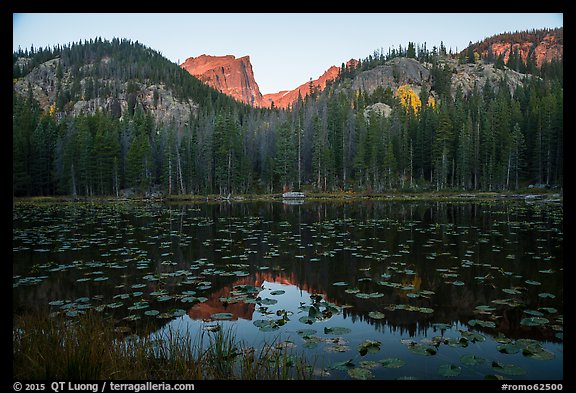Four Lakes in Four miles: a Rocky Mountain National Park Classic
2 Comments
Bear Lake is one of the classic locations in Rocky Mountain National Park. The popular destination is the start of a moderate trail that takes you to four lakes of different character in less than four miles (RT). This post gives tips for photography along the not-to-be-missed trail.
You can can park nearby and circle Bear Lake on a flat trail. As it is easily accessed and is a major trailhead, Bear Lake can become crowded during the day, requiring the use of the free shuttle. As I arrived before dawn, I had no problem parking. Since, based on previous visits, I prefer the afternoon light there, in the morning, I bypassed Bear Lake for the lakes further up the trail, and photographed it on the way back.

Nymph Lake
Nymph Lake (1 mile RT, 225 feet elevation gain) is partly covered with water lilies. You can photograph towards the continental divide in the morning, however only the tops of the peaks are visible. In the afternoon, distant Longs Peak is well illuminated and visible from the west shore. You’ll also find several openings on the trail above Nymph Lake with good views of Longs Peak.


Dream Lake
Dream Lake (2.2 miles RT, 425 feet elevation gain) is at the ideal distance from Flattop Mountain and Hallett Peak, which are prominent from there, but not too close. Since it is said to be the most photographed lake in the park, it can be useful to show up before sunrise to claim your spot for the classic composition near the outlet.

Emerald Lake
The peaks rise straight from Emerald Lake (3.6 miles RT, 625 feet elevation gain), which makes the setting awe-inspiring, but more difficult to photograph – super-wide angle needed! An easy scramble up slabs left of the trail gave me a higher viewpoint. Like for Dream Lake, the best light is from sunrise to early morning. Afterwards, the face of Hallet Peaks goes in the shade.

Bear Lake
Compared to the lakes along the trail, Bear Lake has less of an alpine character. It feels a bit ensconced, especially at the point when you first come upon the shore, with Flattop Mountain and Hallett Peak partly hidden.

However, if you walk counter-clockwise a short (0.25 miles RT) distance to a boulder field on the north shore, you’ll find a more open view which includes Longs Peak in the distance. Rocks provide a foreground and cut the waves for better reflections. Longs Peak is better lit at sunset, but sunrise can sometimes work.

From there, if you are up to scrambling up the boulder field, you‘ll discover a fine view from high above. From an opening between trees, you can photograph the lake in the middle ground, and Longs Peak in the background. The spot is most remarkable in the autumn, when yellow-colored aspens border the field to the west, and orange-colored aspens border it on the east. The aspen are sunlit from the morning to mid/late afternoon, and go in the shade at sunset – which is fine if you can control the dynamic range.

Continuing counter-clockwise along the shore, views of surrounding mountains disappear, but the slope where you found the boulder field and aspen makes for fine reflections in autumn.

View more images of Rocky Mountain National Park


Smart move going to Colorado for fall color this year. Magnificent images and an excellent mini-guide for photographers.
Thanks David. I heard that last year’s Colorado color was actually better, but I had already a fall trip planned in the Northwest. It was all new locations, whereas in RMNP I revisited places I’ve seen before – such as the lakes in this post. Anyway, even on an OK year, Colorado’s fall color is spectacular compared with what we have in California.